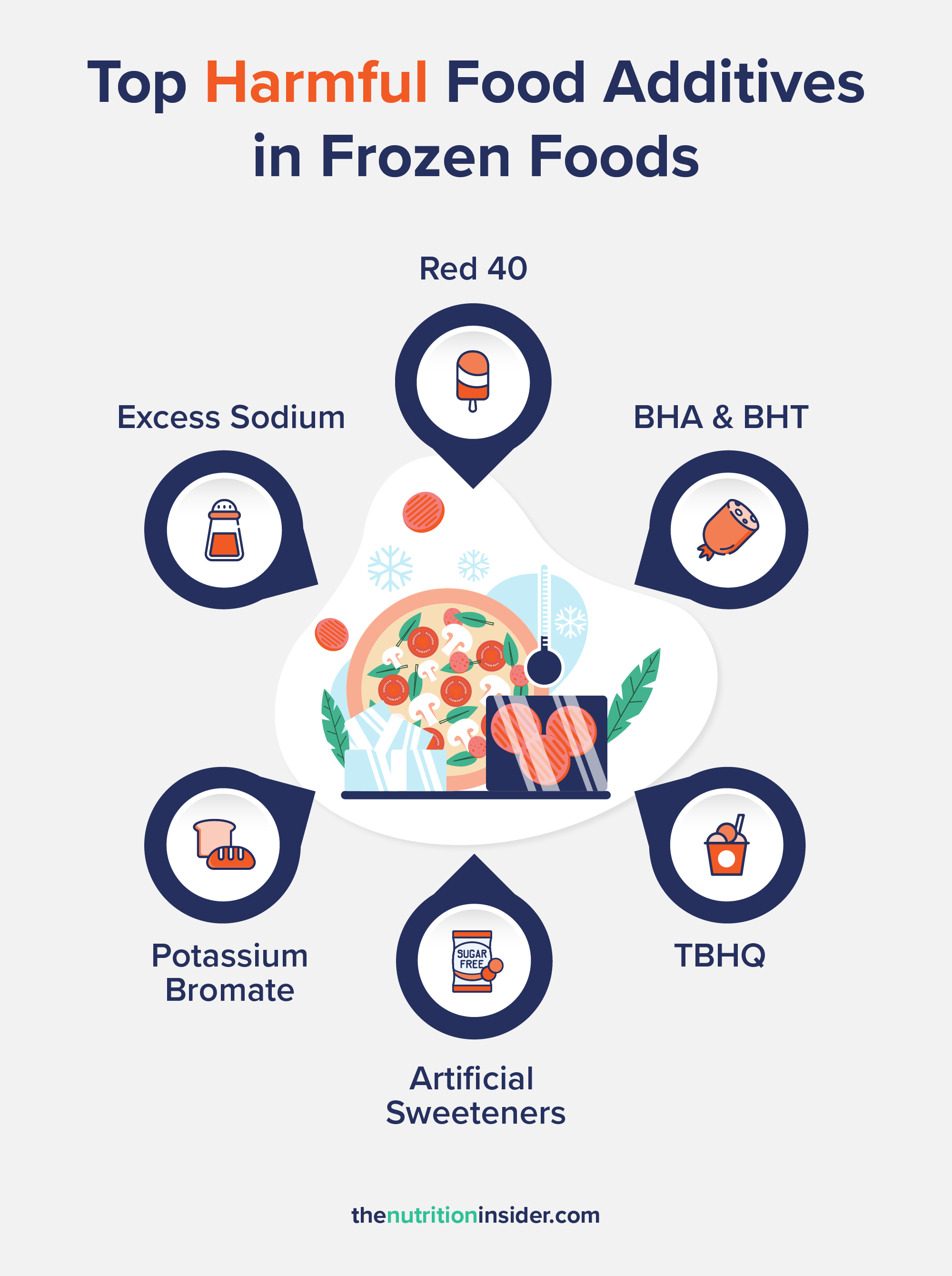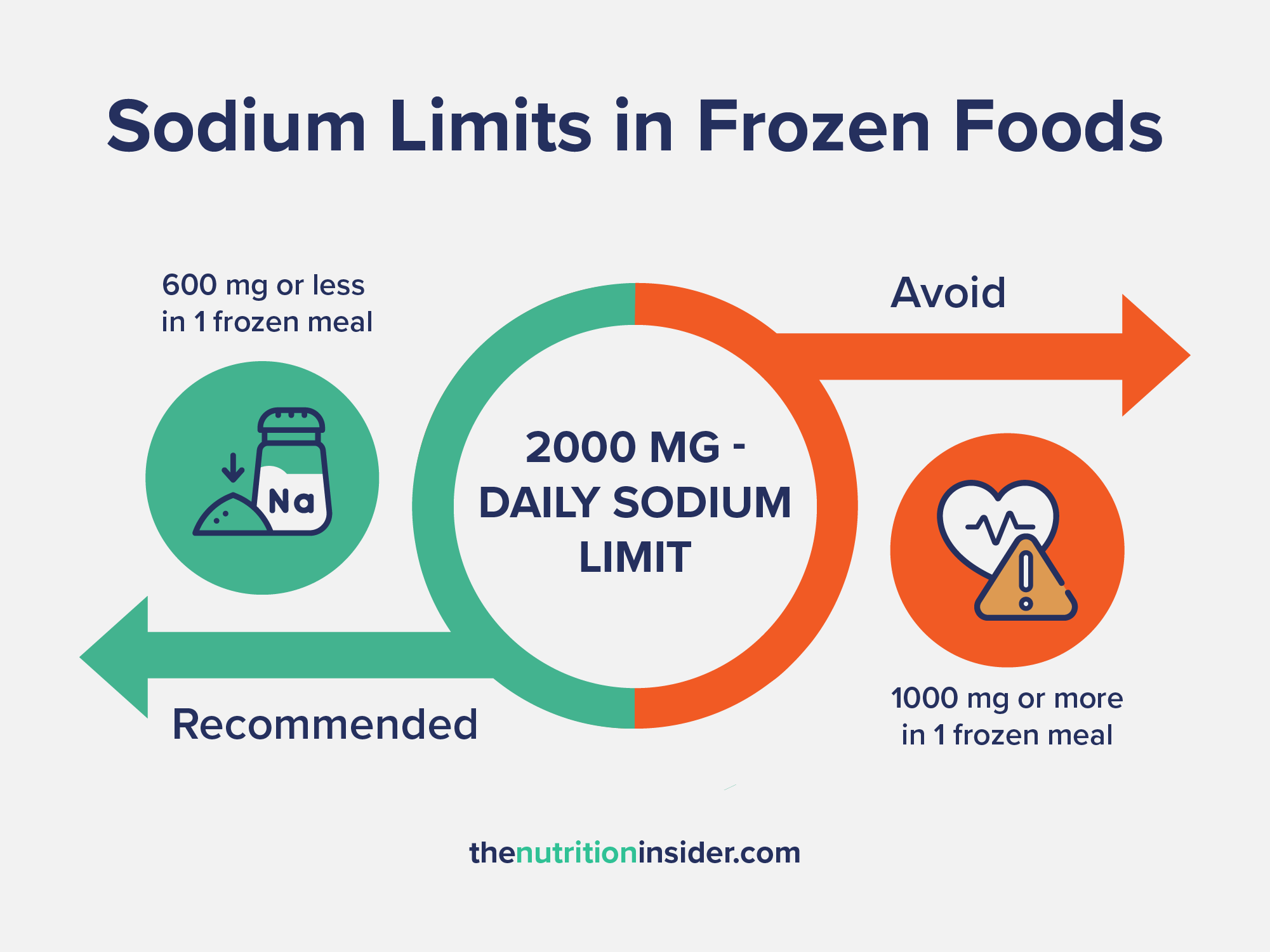Save $40 on your initial consult with a TNI Dietitian!
Talk to a real Dietitian for only $99: Schedule Now
This post contains links through which we may earn a small commission should you make a purchase from a brand. This in no way affects our ability to objectively critique the products and brands we review.
Evidence Based Research To fulfill our commitment to bringing our audience accurate and insightful content, our expert writers and medical reviewers rely on carefully curated research.
Read Our Editorial Policy
Not all frozen foods are bad—in fact, many can be healthy and time-saving additions to your diet.
However, we’re not talking about frozen berries and vegetable medleys here. While we don’t typically like labeling foods as “good” or “bad,” some food additives or ingredients in frozen foods are unhealthy and unwise to consume regularly.
Although one meal will never make or break your health, it would be wise to look for these red flag ingredients the next time you visit the freezer aisle and avoid them when possible.
These ingredients are not just found in frozen foods—you may see them all over the grocery store. Most are found in ultra-processed foods, such as frozen dinners, snack foods, fried foods, “kid” foods like sugary, colorful cereals, prepackaged desserts, and many other packaged foods.

Popsicles, ice cream, frozen pizza, and other frozen desserts are likely to contain artificial food dyes like Red 40.
Red 40 is one of nine color additives currently approved by the FDA, along with Blue 1, Yellow 5, Red 3, and others.
Synthetic food dyes were initially derived from coal tar—now, they are made from petroleum or crude oil and mixed with various chemicals.
Some of the Red Dye 40 ingredients include benzidine, 4-aminobiphenyl, and p-cresidine, which has been classified by the Department of Health and Human Services National Toxicology Program as carcinogenic in animals and “reasonably anticipated to be a human carcinogen.”1
Other artificial food dyes, including Red 40, Yellow #5, and Yellow #6, have also been found to be contaminated with carcinogens.2
Although research is not always conclusive, artificial food coloring like Red 40 has been linked to increased hyperactivity in children with ADHD, an increased risk of inflammatory bowel disease, and potentially an increased risk of cancer.3,4
One of the carcinogenic compounds in Red 40 and other colorants is benzidine, which has been linked to an increased risk of bladder cancer in humans who were occupationally exposed to the chemical.5
Butylated hydroxyanisole (BHA) and butylated hydroxytoluene (BHT) are commonly used food preservatives.
While they are more often seen in shelf-stable or refrigerated foods to extend their shelf life, frozen foods like burger patties, frozen dinners (like TV or tray dinners), processed meat items, pizza, and burritos might contain BHA or BHT.
The National Toxicology Program classifies BHA as “reasonably anticipated to be a human carcinogen,” and the IARC calls it a Group 2B carcinogen (“possibly carcinogenic to humans”).6,7
Research has shown that BHA is linked to endocrine disruption, thyroid system damage, metabolic and growth disorders, carcinogenesis, and neurotoxicity.8
Although BHA has been studied more, BHT is similar to BHA and may lead to similar effects, especially with endocrine disruption.
Tert-butyl hydroquinone (TBHQ) is another preservative added to frozen food, and it may also have carcinogenic effects.9
The Environmental Working Group (EWG) has also found that TBHQ is linked to immune system dysregulation in cell-based and animal studies.10
The EWG compiled a list of processed foods that contain TBHQ, which includes many types of ice cream, pizza, and other frozen desserts.11
Non-caloric and artificial sweeteners like aspartame, sucralose, saccharin, or acesulfame-K might be found in frozen foods such as “lite” or “diet” ice creams, popsicles, or other desserts.
Although artificial sweeteners can reduce caloric and sugar intake, there are many potential downsides.
Aspartame has been classified as a possible carcinogen, while all artificial sweeteners are associated with increased weight gain, altered glucose metabolism, and disrupted gut microbiomes.12-15
Potassium bromate is a dough conditioner that makes larger batches of dough easier to handle and lighter, yet tough enough to withstand shipping and storage.
It’s commonly added to bread products. In the freezer aisle, you may see it in foods like frozen pizza, frozen dumplings, frozen pie or pizza crusts, or other bread-containing items.
Although potassium bromate is banned in the European Union and several other countries, it’s still used in the United States. However, in 2023, some states (like California) started the process of banning it. By 2027, the California Food Safety Act will be in place, banning the use and distribution of potassium bromate (in addition to propylparaben, Red Dye No. 3, and brominated vegetable oil).16
This is well overdue, as the International Agency for Research on Cancer classified potassium bromate as a possible human carcinogen as far back as 1999 when research showed that the compound caused cancer in rats.17
Azodicarbonamide is found in many commercial baked goods as a dough conditioner, like potassium bromate.
You may remember azodicarbonamide as the “yoga mat chemical” found in Subway bread from a few years back, but it’s still widespread in baked goods—including frozen bread, pastries, or other baked goods.18
Although azodicarbonamide is not approved for use in Australia or the European Union, it is still used in the U.S. In the 1990s, it was adopted as a safer substitute for potassium bromate—but it might not be much better.
The Center for Science in the Public Interest (CSPI) recommends avoiding azodicarbonamide due to insufficient data and the development of two potential carcinogenic compounds when azodicarbonamide-containing bread is baked.19
Frozen foods (especially prepared frozen foods, like pizza or tray dinners) are notoriously high in sodium, which is something else to look out for.
Many frozen meals contain 2,000 milligrams of sodium or more per serving, which is about what someone should eat in an entire day.
Although salt is not bad for us, we don’t want to consume it in excess, as it is linked to high blood pressure and heart disease. One study found that each 1,000mg increase in dietary sodium intake is linked to a 6% increased risk of cardiovascular disease.20
Look for frozen foods with 500-600mg of sodium per serving or less, and definitely not exceeding 1,000mg.

One ingredient you’ll want to avoid at all costs is trans fat. Although trans fats were banned in 2018 and are no longer generally recognized as safe (GRAS) by the FDA, some lingering food products that have escaped detection may still use them.21 Look for the phrase “partially hydrogenated oil” and do not consume that product, as trans fats are undeniably linked to heart disease.
You may wonder why trans fats are still on the nutrition facts label if they have been banned. This is because the FDA ruling does not affect naturally occurring trans fat, which is a healthy type found naturally in meat and dairy from cows and goats.
Some frozen food can definitely be healthy, while many others are not. Frozen food can entail anything from wild organic blueberries to loaded triple-meat supreme pizzas. Look for frozen food products without any of the food additives listed in this article (trans fat, BHA, BHT, TBHQ, Red 40 or other artificial food colorings, artificial sweeteners, potassium bromate, or azodicarbonamide). Look at the sodium content and aim for 500-600mg per serving or less.
Ultra-processed foods include most packaged foods, such as cookies, sodas, hot dogs, processed meats, frozen pizza, frozen TV/tray dinners, most salty snacks (like chips and crackers), frozen desserts, prepackaged baked goods or pastries, candy, white bread, and fast food.
Almost all foods are processed to some degree, so “processed” does not always mean unhealthy. For example, olive oil, baby carrots, and canned tuna are all considered processed. However, ultra-processed or heavily processed foods are ones to avoid or limit. These foods are never found in nature and have gone through a lot of different processing steps to become what they are—which is almost always packaged foods. For example, sliced apples and unsweetened organic applesauce are lightly processed versions of apples, while Hostess Apple Fruit Pies are ultra-processed. The farther away a food gets from its natural state, the more processed it is. Ultra-processed foods contain more food additives and sugars like high-fructose corn syrup or artificial sweeteners.